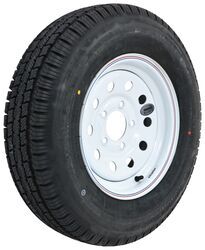
Trailer Tire Sizes and Nitrogen vs. Air for Inflation for Use in Hot Weather Long-Distance Driving
Question:
I have a small utility trailer 5x8 rigged with a ladder rack on it to carry a canoe. Im planning a trip to Moab Utah from Billings Mt in August. The highways will be HOT! I have 12inch radial trailer tires on it that are fairly new but a gent at a boat dealership here said Id be better off with 13inch bias as they will turn slower than the smaller tire and will be cooler. Its a 13 hour non stop drive and the pavement will likely be around 110 F. I can fit either tire and I will most likely get new tires before I go. 2nd question...I have access to all the nitrogen I want where I work. Any benefit to filling the tires with nitrogen? Thank you.
asked by: Jeff S
Expert Reply:
You ask an interesting series of questions!
Tire size in and of itself, going from a 12-inch to a 13-inch size, will not have a significant effect on tire temperatures. It is true that a larger diameter tire will make slightly fewer revolutions than a smaller tire in any given distance, but this is pretty much incidental to its operating temperature as compared to other factors.
The air we breathe is 78-percent nitrogen; the rest is made up of about 21-percent oxygen, some other trace gases like carbon dioxide and water vapor. A key advantage of pure nitrogen is that it tends to migrate through the rubber (leak out) less than air. It also has a more stable volume with temperature, so if going from 40-degrees to 100-degrees air will expand in volume a bit more than nitrogen will. Another benefit of nitrogen is that it contains no water vapor. Air with lots of water vapor will cause pressure changes greater than if the air in the tires is dry. Water in a tire can also cause corrosion.
With all of that said, you will not feel any difference in handling between air and nitrogen, assuming the inflation pressures are correct for the ambient temperature. Also note that filling tires with nitrogen takes several cycles of inflation and deflation to get all of the air and most of the moisture out of the tire. It is not a one-shot process.
In desert regions 50 to 60 degrees (Fahrenheit) would be an average temperature change from day and night. The rule of thumb on tire pressure change due to air temperature is 1 psi for every 10 degrees (Fahrenheit) in temperature change. If you start out in the morning at 50-degrees and end up midday at 100-degrees outside temperature this would be a 5 or 6 psi gain in pressure. This is not terribly significant.
Keep in mind that it is much better for a tire to be slightly over its rated psi than to be under it. The main thing to do is to make sure your tires are properly inflated when you head out, no matter which gas you use. They also need to be of the correct rating for the load on them.
Some tire makers may have different thinking than others on this nitrogen question so you might check with the maker of your trailer tires for their position. Odds are if you call two trailer tire makers you'll get two different answers!
We do sell both bias ply and radial trailer tires, wheels and tires/wheels already mounted. You can use the link provided to see all three product categories and filters on the page will allow you to choose the characteristics you need, including wheel bolt pattern, tire load range, size and tire type.
For example, if you need a 13-inch radial trailer tire in load range C with a 5-on-4-1/2-inch bolt pattern we offer Taskmaster # TA43RR.

Product Page this Question was Asked From
Provider ST175/80R13 Radial Trailer Tire w/ 13" Vesper White Mod Wheel - 5 on 4-1/2 - LRC
- Trailer Tires and Wheels
- Tire with Wheel
- Radial Tire
- Load Range C
- 175/80-13
- 13 Inch
- M - 81 mph
- 5 on 4-1/2 Inch
- Steel Wheels - Acrylic Enamel
- Taskmaster
more information >
Featured Help Information
Miscellaneous Media

Continue Researching
- Article: Trailer Tire Sizing
- Q&A: Is there a 12 Inch Trailer Tire that is Rated for 80 Miles Per Hour
- Q&A: SuperSprings Custom Stabilizer and Sway Kit For a 2004 Chevrolet Silverado 2500HD
- Q&A: Replacement Grease Seal for a 168255TC Rubber Coated Seal
- Q&A: Wiring Adapter For 2009 Porsche Cayenne With 7-Way Connector Towing Trailer With 4-Pole Connector
- Q&A: Can 12 Inch Trailer Tires and Wheels be Replaced with 13 Inch
- Article: How to Measure Your Trailer Wheel Bolt Pattern
- Q&A: Can a 5.30-12 Size Tire be Replaced with a ST145/R12 Size Tire
- Q&A: Finding Correct Trailer Wheels to Match Hubs for a BT8 Spindle
- Article: How to Raise Your Travel Trailer Height
- Article: 7 Common Questions Everyone Has About Trailer Tires
- Article: How to Determine Tire/Wheel Diameter
- Article: Trailer Maintenance Schedule
- Article: Measuring a Trailer Tire





